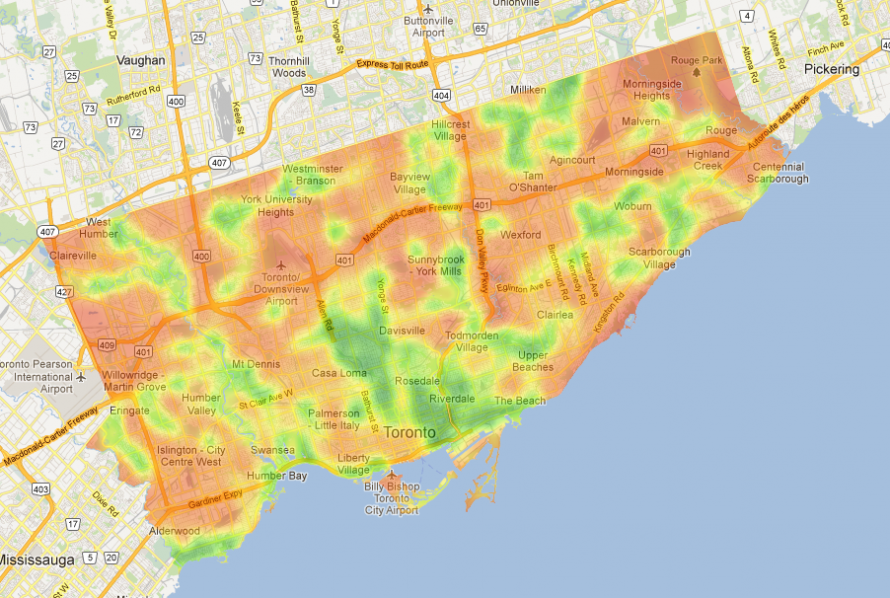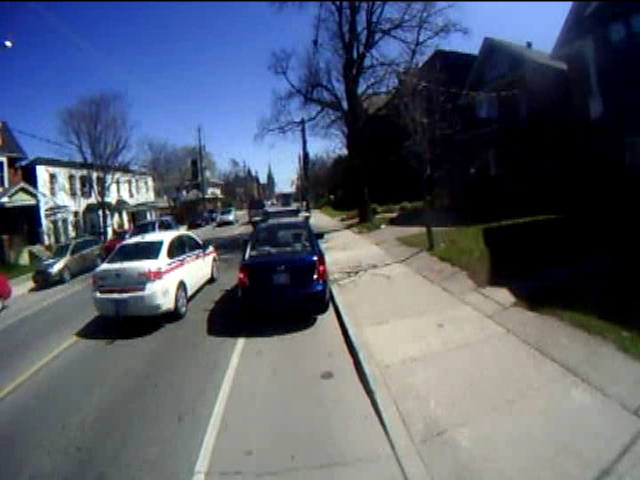Reportedly they decided in the end to go with a less clichéd t-shirt for Bike Month 2012.

Walk Score had recently released a scoring system for cycling in collaboration with researchers from Cycling in Cities, a University of British Columbia research program. A number of American and Canadian cities now have scores, including Toronto.
There is something odd going on with Toronto. The places where the highest percentages of commuters use bicycles also have a high chance of being areas with low Bike Scores. I overlayed a map of the bicycle mode share across Toronto from Statistics Canada. The following is just the bike commuter mode share:
I then tried to merge the two in the following image. Where bike mode share is high but the Bike Score is poor it shows up as purplish. Where bike mode share is high and the Bike Score is good it shows up as bluish-green.
 cnaComparing Bike Score to Mode Share in Toronto
cnaComparing Bike Score to Mode Share in Toronto
Why do Torontonians bike despite a poor Bike Score?
There are three possible explanations. Bike Score is trying to measure whether a location is "good for biking" and not necessarily correlate with high bike mode shares. Bike Score might be missing, or not giving enough weight to, some factors that make Toronto neighbourhoods bike-friendly. Or Bike Score data is inaccurate and misses some key bike infrastructure. I think it's a combination of the three.
Bike Score will never match perfectly with mode share. It appears that averaged across a city that there is a strong correlation of mode share and Bike Score. Yet this isn't true for areas of Toronto. Bike Score actually takes into account bike commuting mode share when coming up with the measure. An obvious way to increase the match would be to give mode share a higher weighting. But make it too high and it just becomes a a mode share measure and not one of "bikeability".
Bike Score is based on the Cycling in Cities research, which included these environmental factors important to cyclists:
- cycling infrastructure (separated bike lanes and bike paths, local street bikeways, painted bike lanes)
- topography (hilliness)
- desirable amenities (grocery stores, restaurants, schools, etc.) and road connectivity (both are components of Walk Score, which was used to capture these elements within Bike Score)
There seems to be missing data. In the Trinity Bellwoods area, for example, the mode share is one of the highest in the city, yet the Bike Score is quite poor. Part of this breakdown may be due to what seems to be missing College and Harbord bike lanes (there doesn't appear to be a green smudge where they are). These are two of the best used bike lanes in the city. Bike Score should get more accurate data from the City of Toronto.
Aside from these omissions there still seems to be disconnect so let's speculate on other factors that influence high bike mode share. One factor is destination (distance to desirable amenities and road connectivity). They include destination as a heat map and it appears to match bike mode share more closely than their overall Bike Score. Should they give destination more weighting?
Another factor is the friendliness of residential streets. While the main arteries of Toronto seldom have bike lanes, the residential streets provide respite for the speed and chaos of traffic. Local street bikeways are included but unlike other cities like Vancouver Toronto residential streets often don't have any bike-specific features yet can still be bikeable.
Another factor is cultural influence. Cycling rates have increased in Toronto at a much higher rate than the increase in cycling infrastructure. In areas where people can see "ordinary" women and men of all ages cycling, it becomes much easier for other people to see themselves as cycling as well. Since Bike Score already incorporates a mode share component it appears as if either this data is missing for Toronto or they might need to give it a higher weighting. As Bike Score says, "We believe as more people in your social network bike, there's a stronger chance that you will bike."
Since Bike Score is in beta it will inevitably improve by adding more accurate data and perhaps changing the weighting of items over time. I look forward to seeing how it will develop and be used by researchers, business and government.

I have another video; this one makes the point that we need better enforcement of bicycle lanes. Too often, drivers seem to think they can legally pull into a bike lane to load and unload, or to take (or make) a cell phone call. It doesn't help when police, as shown in this video, ignore infractions. They don't have to ticket every offender; just speak up and educate the drivers, or at least move them along.
- ‹ previous
- Page 63
- next ›


